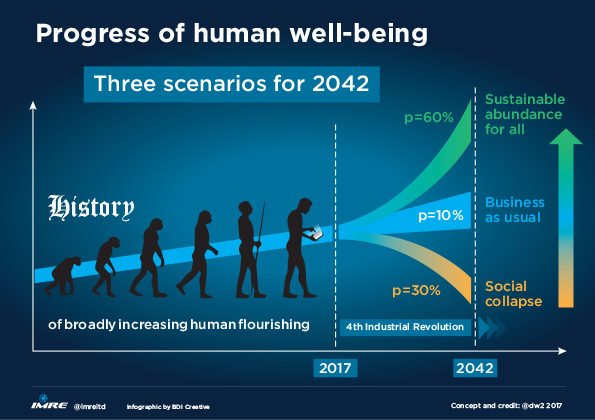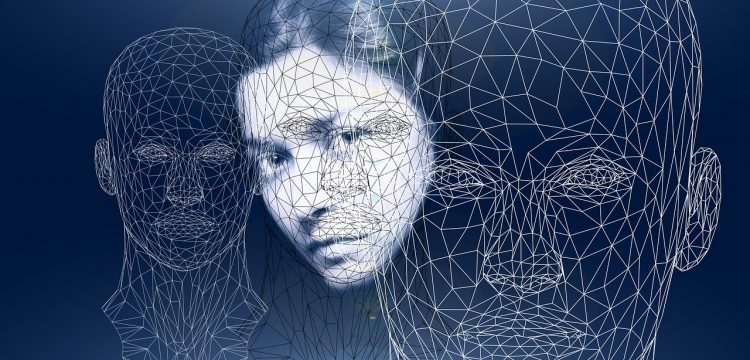Foresight as a strategic intelligence tool
Liège, January 19, 2018
PhD2050 (Philippe Destatte)
Rien dans l’univers ne peut résister à l’ardeur convergente d’un nombre suffisamment grand d’intelligences groupées et organisées (Teilhard, 1947)
1. What is foresight, and in what way is it strategic? [1]
In the form in which we know it today in Europe, foresight represents an encounter and interaction between French and Latin developments, on the one hand, and those in the Anglosphere on the other. In English-speaking countries, the practice of foresight has evolved over time from a concern with military interests (such as improving defence systems) to industrial objectives (such as increasing competitiveness) and societal issues (such as ensuring the welfare of the population or ensuring social harmony). Since the 1960s, its chosen field has shifted from fundamental science to key technologies, then to the analysis of innovation systems, and finally to the study of the entire societal system. Having started out within a single discipline, namely the exact sciences, foresight has become pluridisciplinary, multidisciplinary and interdisciplinary, with an openness to the social sciences [2]. In doing so, it has moved considerably closer to the French approach, abandoning many of its earlier forecasting ambitions for a more strategic focus.
The French school of foresight (referred to as la prospective) originates in the thought of the philosopher and entrepreneur Gaston Berger. Deriving from a philosophy of collective action and engagement, it deals with value systems and constructs knowledge for political purposes [3], and has likewise become increasingly strategic in nature through contact with the worlds of international organisations, companies and regional territories [4]. Taking account of the long-term and la longue durée by postulating the plurality of possible futures, adopting the analysis of complex systems and deploying the theory and practice of modelling, foresight generates a strategic desire and willingness in order to influence and affect history. As I have helped to define it in various contexts – European (the Mutual Learning Platform of DG Research, DG Enterprise & Industry, and DG Regional & Urban Policy, supported by the Committee of the Regions) [5], French (the European Regional Foresight College) created under the auspices of the Interministerial Delegation of Land Planning and Regional Attractiveness (DATAR) in Paris) [6] or in Wallonia (the Wallonia Evaluation and Foresight Society) [7]– foresight is an independent, dialectical and rigorous process, conducted in a transdisciplinary way and taking in the longer sweep of history. It can shed light on questions of the present and the future, firstly by considering them in a holistic, systemic and complex framework, and secondly by setting them in a temporal context over and beyond historicity. Concerned above all with planning and action, its purpose is to provoke one or more transformations within the system that it apprehends by mobilising collective intelligence [8]. This definition is that of both la prospective and foresight; at any rate it was designed as such, as part of a serious effort to bring about convergence between these two tools undertaken by, in particular, the team of Unit K2 of DG Research and Innovation at the European Commission, led at the time by Paraskevas Caracostas.
The main distinguishing characteristic of the strategy behind the process of la prospective or foresight – some refer to la prospective stratégique or strategic foresight, which to my mind are pleonasms – is that it does not have a linear relationship with the diagnosis or the issues. Fundamentally, this tool reflects both the long-term issues it seeks to address and a vision of a desirable future that it has constructed with the actors concerned. Its circular process mobilises collective and collaborative intelligence at every step in order to bring about in reality a desired and jointly constructed action that operates over the long term and is intended to be efficient and operational. Foresight watch takes place at every step of this process. I define this as a continuous and largely iterative activity of active observation and systemic analysis of the environment, in the short, medium and long term, to anticipate developments and identify present and future issues with the ultimate purpose of forming collective visions and action strategies. It is based on creating and managing the knowledge needed as input into the process of foresight itself. This process extends from the choice of areas to work on (long-term issues) and of the necessary heuristic, via the analysis and capitalisation of information and its transformation into useful knowledge, to communication and evaluation [9].
2. Foresight and strategic intelligence
The Strategic Intelligence Research Group (GRIS) at HEC Liège, under the direction of Professor Claire Gruslin, sees strategic intelligence as ‘a mode of governance based on the acquisition and protection of strategic and relevant information and on the potential for influence, which is essential for all economic actors wishing to participate proactively in development and innovation by building a distinctive and lasting advantage in a highly competitive and turbulent environment’ [10].
For its part, the famous Martre Report of 1994, in its definition of economic intelligence, delineated a process fairly similar to that which I mentioned for foresight, likewise including monitoring, heuristics, the examination of issues, a shared vision and the strategy to achieve it, all set in a ‘continuous cycle’:
‘Economic intelligence can be defined as the set of coordinated actions by which information that is useful to economic actors is sought out, processed and distributed for exploitation. These various actions are carried out legally and benefit from the protection necessary to preserve the company’s assets, under optimal quality, time and cost conditions. Useful information is that needed by the different decision-making levels in the company or the community in order to develop and implement in a coherent manner the strategy and tactics necessary to achieve its objectives, with the goal of improving its position in its competitive context. These actions within the company are organised in a continuous cycle, generating a shared vision of the objectives to be achieved’ [11].
What is of particular interest in the search for parallels or convergences between economic intelligence and foresight is the idea, developed by Henri Martre, Philippe Clerc and Christian Harbulot, that the notion of economic intelligence goes beyond documentation, monitoring, data protection or even influence, to become part of ‘a true strategic and tactical intention’, supporting actions at different levels, from the company up to the global, international level[12].
3. Foresight in strategic intelligence
At the turn of the millennium, as part of the European ESTO (European Science and Technology Observatory) programme, the Institute for Prospective Technological Studies (IPTS) in Seville gathered a series of researchers to examine the idea of strategic intelligence as a methodological vehicle or umbrella for public policy-making. The idea was to recognise and take account of the diversity of methods made available to decision-makers in order to structure and mobilise them to ensure successful policy-making [13]. As Ken Ducatel, one of the coordinators of this discussion, put it, ‘The concept of strategic intelligence not only offers a powerful methodology for addressing (EU) issues, but has the flexibility to connect to other forms of interaction, adapt to new models of governance and open up to technological changes and social developments that are faster than we have ever known before’ [14].
At the time of the REGSTRAT project coordinated by the Stuttgart-based Steinbeis Europa Zentrum in 2006, the concept of Strategic Policy Intelligence (SPI) tools – i.e. intelligence tools applied to public policy – had become accepted, in particular among the representatives of the Mutual Learning Platform referred to earlier. As my fellow foresight specialist Günter Clar and I pointed out in the report on the subject of foresight, strategic intelligence as applied to public policy can be defined as a set of actions designed to identify, implement, disseminate and protect information in order to make it available to the right person, at the right time, with the goal of making the right decision. As had become clear during the work, SPI’s tools include foresight, evaluation of technological choices, evaluation, benchmarking, quality procedures applied to territories, and so on. These tools are used to provide decision-makers and stakeholders with clear, objective, politically unbiased, independent and, most importantly, anticipatory information [15].
This work also made it possible to define strategic intelligence as observed in this context. Its content is adapted to the context, with hard and soft sides and a distributed character, underpinned by scale effects, the facilitation of learning, a balance between specific and generic approaches and increased accessibility. Its process is based on demand, the need to mobilise creativity, making tacit knowledge explicit, the evaluation of technological potential, a facilitation of the process and an optimal link with decision-making [16].
From this viewpoint, foresight is clearly one of the tools of strategic intelligence for the use of policy-makers and stakeholders.
Anticipation, innovation and decision-making
The Directorate General for Research and Innovation of the European Commission has been involved for some years in forward-looking activities (FLAs) [17], just as the European Institute in Seville had been – as we saw – when it developed strategic policy intelligence (SPI) [18] tools for use in public policy-making[19]. FLAs include all systematic and participatory studies and processes designed to consider possible futures, proactively and strategically, and to explore and map out paths towards desirable goals [20]. This field obviously includes numerous different methods for anticipation of future developments, evaluation of technological choices, ex-ante evaluation, and so on.
In 2001, Ruud Smits, Professor of Technology and Innovation at the University of Utrecht, made three recommendations that he regarded as essential. First, he stressed, it was time to call a halt to the debate about definitions and to exploit the synergies between the different branches of strategic intelligence. Next, he noted the need to improve the quality of strategic intelligence and reinforce its existing sources. Finally, Smits called for the development of an interface between strategic intelligence sources and their users[21]. This programme has yet to be implemented, and our work at GRIS could be seen as reflecting this ambition.
This cognitive approach without a doubt brings us back to the distinction put forward by psychologist and Nobel Prize winner Daniel Kahneman, who refers in his book Thinking fast and slow to two cerebral systems. He describes System 1 as automatic, direct, impulsive, everyday, fast, intuitive, and involving no real effort; we use it in 95% of circumstances. System 2, by contrast, is conscious, rational, deliberative, slow, analytical and logical; we only use it 5% of the time, especially to make decisions when we find ourselves in systems that we consider complex[22]. It is at such times that we have to make the effort to mobilise tools suited to the tasks we are tackling.
This question concerns all strategic intelligence tools, including foresight. Not just because the investments to be made in these fields of research are considerable, but because, often, many of us are unaware of the extent of that which we are unable to understand. All too commonly, we think that what we can see represents the full extent of what exists. We confine ourselves to the variables that we are able to detect, embrace and measure, and have a considerable capacity to refuse to recognise other variables. We know that this syndrome of WYSIATI (‘what you see is all there is’) is devastating: it prevents us from grasping reality in its entirety by making us think that we are in full command of the territory around us and the horizon. As Kahneman puts it, ‘You cannot help dealing with limited information you have as if it were all there is to know’ [23].
This flaw – and there are others – should encourage us to join forces to cross methodological and epistemological boundaries and work to create more robust instruments that can be used to design more proactive and better-equipped public policies.
Philippe Destatte
[1] A first version of this paper was presented at the Liège Business School on September 28, 2016.
[2] Paraskevas CARACOSTAS & Ugar MULDUR, Society, The Endless Frontier, A European Vision of Research and Innovation Policies for the 21st Century, Brussels, European Commission, 1997.
[3] ‘(…) By applying the principles of intentional analysis associated with phenomenology to the experience of time, Gaston Berger substitutes for the “myth of time” a temporal norm, an intersubjective construct for collective action. His philosophy of knowledge is thus constituted as a science of foresight practice whose purpose is normative: it is oriented towards work on values and the construction of a political project; it is a “philosophy in action”.‘ Chloë VIDAL, La prospective territoriale dans tous ses états, Rationalités, savoirs et pratiques de la prospective (1957-2014), p. 31, Lyon, Thèse ENS, 2015. Our translation.
[4] On la prospective territoriale, representing an encounter between the principles of foresight and those of regional development, see the reference to the DATAR international conference in March 1968. Chloë VIDAL, La prospective territoriale dans tous ses états, Rationalités, savoirs et pratiques de la prospective (1957-2014)…, p. 214-215.
[5] Günter CLAR & Philippe DESTATTE, Regional Foresight, Boosting Regional Potential, Mutual Learning Platform Regional Foresight Report, Luxembourg, European Commission, Committee of the Regions and Innovative Regions in Europe Network, 2006.
[6] Ph. DESTATTE & Ph. DURANCE eds, Les mots-clefs de la prospective territoriale, p. 43, Paris, DIACT-DATAR, La Documentation française, 2009.
[7] Ph. DESTATTE, Evaluation, prospective et développement régional, p. 381, Charleroi, Institut Destrée, 2001.
[8] Ph. Destatte, What is foresight ?, Blog PhD2050, May 30, 2013.
https://phd2050.wordpress.com/2013/05/30/what-is-foresight/
[9] René-Charles TISSEYRE, Knowledge Management, Théorie et pratique de la gestion des connaissances, Paris, Hermès-Lavoisier, 1999.
[10] Guy GOERMANNE, Note de réflexion, Tentatives de rapprochement entre la prospective et l’intelligence stratégique en Wallonie, p. 7, Brussels, August 2016, 64 p.
[11] Henri MARTRE, Philippe CLERC, Christian HARBULOT, Intelligence économique et stratégie des entreprises, p. 12-13, Paris, Commissariat général au Plan (Plan Commission) – La Documentation française, February 1994.
http://bdc.aege.fr/public/Intelligence_Economique_et_strategie_des_entreprises_1994.pdf
[12] ‘The notion of economic intelligence implies transcending the piecemeal actions designated by the terms documentation, monitoring (scientific and technological, competitive, financial, legal and regulatory etc.), protection of competitive capital, and influencing (strategy for influencing nation-states, role of foreign consultancies, information and misinformation operations, etc). It succeeds in transcending these things as a result of the strategic and tactical intention which is supposed to preside over the steering of piecemeal actions and over ensuring their success, and of the interaction between all levels of activity at which the economic intelligence function is exercised: from the grassroots (within companies), through intermediate levels (interprofessional, local), up to the national (concerted strategies between different decision-making centres), transnational (multinational groups) or international (strategies for influencing nation-states) levels.’ H. MARTRE, Ph. CLERC, Ch. HARBULOT, Intelligence économique et stratégie des entreprises…, p. 12-13. Our translation.
[13] Strategic intelligence can be defined as a set of actions designed to identify, implement, disseminate and protect information in order to make it available to the right person, at the right time, with the goal of making the right decision. (…) Strategic intelligence applied to public policy offers a variety of methodologies to meet the requirements of policy-makers. Derived from Daniel ROUACH, La veille technologique et l’intelligence économique, Paris, PUF, 1996, p. 7 & Intelligence économique et stratégie d’entreprises, Paris, Commissariat général au Plan (Plan Commission), 1994. – Alexander TÜBKE, Ken DUCATEL, James P. GAVIGAN, Pietro MONCADA-PATERNO-CASTELLO eds, Strategic Policy Intelligence: Current Trends, the State of the Play and perspectives, S&T Intelligence for Policy-Making Processes, p. V & VII, IPTS, Seville, Dec. 2001.
[14] Ibidem, p. IV.
[15] Günter CLAR & Ph. DESTATTE, Mutual Learning Platform Regional Foresight Report, p. 4, Luxembourg, IRE, EC-CoR, 2006.
[16] Ruud SMITS, The New Role of Strategic Intelligence, in A. TÜBKE, K. DUCATEL, J. P. GAVIGAN, P. MONCADA-PATERNO-CASTELLO eds, Strategic Policy Intelligence: Current Trends, p. 17.
[17] Domenico ROSSETTI di VALDALBERO & Parla SROUR-GANDON, European Forward Looking Activities, EU Research in Foresight and Forecast, Socio-Economic Sciences & Humanities, List of Activities, Brussels, European Commission, DGR, Directorate L, Science, Economy & Society, 2010. http://ec.europa.eu/research/social-sciences/forward-looking_en.html – European forward-looking activities, Building the future of « Innovation Union » and ERA, Brussels, European Commission, Directorate-General for Research and Innovation, 2011. ftp://ftp.cordis.europa.eu/pub/fp7/ssh/docs/european-forward-looking-activities_en.pdf
[18] ‘Strategic Intelligence is all about feeding actors (including policy makers) with the tailor made information they need to play their role in innovation systems (content) and with bringing them together to interact (amongst others to create common ground).’ Ruud SMITS, Technology Assessment and Innovation Policy, Seville, 5 Dec. 2002. ppt.
[19] A. TÜBKE, K. DUCATEL, J. P. GAVIGAN, P. MONCADA-PATERNO-CASTELLO eds, Strategic Policy Intelligence: Current Trends, …
[20] Innovation Union Information and Intelligence System I3S – EC 09/06/2011.
[21] R. SMITS, The New Role of Strategic Intelligence…, p. 17. – see also R. SMITS & Stefan KUHLMANN, Strengthening interfaces in innovation systems: rationale, concepts and (new) instruments, Strata Consolidating Workshop, Brussels, 22-23 April 2002, RTD-K2, June 2002. – R. SMITS, Stefan KUHLMANN and Philip SHAPIRA eds, The Theory and Practice of Innovation Policy, An International Research Handbook, Cheltenham UK, Northampton MA USA, Edward Elgar, 2010.
[22] Daniel KAHNEMAN, Thinking fast and slow, p. 201, New York, Farrar, Straus and Giroux, 2011.
[23] D. KAHNEMAN, Thinking fast and slow, p. 201.











